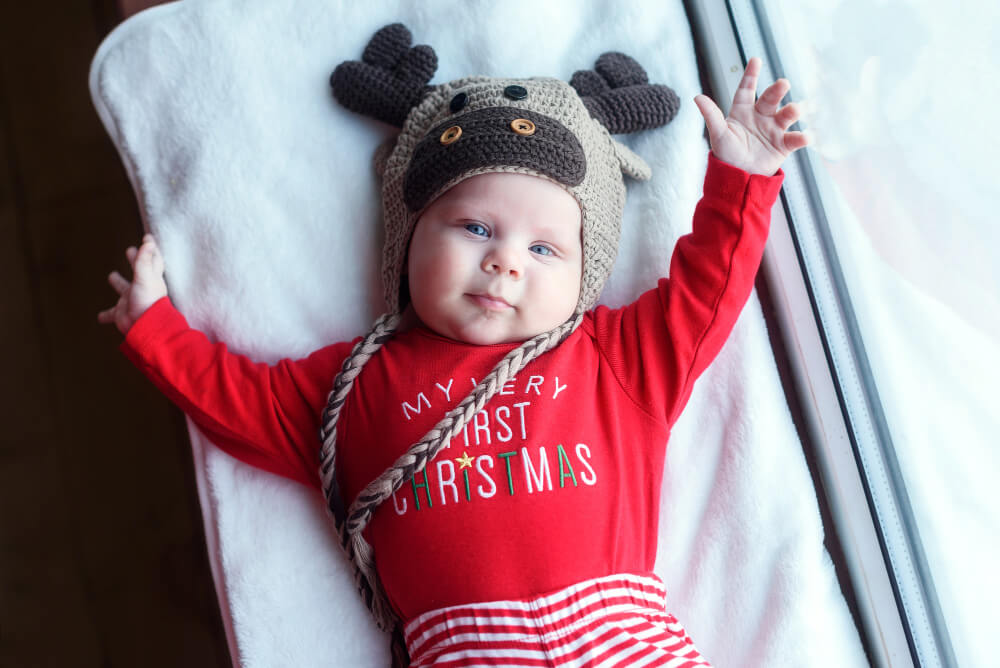Winter is a magical season, but for new parents, it brings the challenge of keeping their tiny, delicate newborn warm and cozy without overheating. Newborns have a more challenging time regulating body temperature, making it essential to follow ‘’Goldilocks’’ rules for dressing them: not too hot or cold, but just right.
The good news is that the proper layering techniques and tips can help you confidently dress your newborn for winter and keep them cozy and safe throughout the season.
Let's get into all you need to know to prepare your newborn baby for cold days and icy nights!
Why Newborns Need Extra Care in Winter
Newborns have an underdeveloped thermoregulatory system (the body's temperature control system), which makes them especially vulnerable to hypothermia (abnormally low body temperature) and overheating. Their bodies lose heat quickly, and they cannot shiver, which is the body’s natural way of generating warmth.
Therefore, dressing them in appropriate clothing and choosing high-quality fabrics is essential to maintaining an ideal body temperature.
Must-Have Winter Clothing for Your Newborn

Choosing the right winter clothes is the first step in keeping your newborn warm and cozy in winter. Essential items include:
Bodysuit or Onesies: Use durable, long-sleeved bodysuits as a base layer. Opt for soft, breathable fabrics like organic cotton, which wicks moisture away while keeping your baby warm and comfortable.
Footed Pajamas or Sleepers: These one-piece outfits give full-body coverage, keeping your baby warm from neck to toe. Choose fleece or thick cotton sleepers for extra insulation on very cold nights.
Sweaters and Cardigans: Soft, easily removable sweaters or cardigans can provide supplementary insulation and allow for temperature adjustments. Button-up or zippered designs are preferable to avoid disturbing a sleeping baby.
Winter Coat or Snowsuit: A warm coat or, ideally, a snowsuit is also a must to keep your baby warm and dry for outdoor outings. Pick one with an easy-on, easy-off design for convenience.
Hats: Much of your body heat escapes through your head, so a tight-fitting hat is important for warmth. A fleece or knit cap with ear flaps is ideal for better coverage.
Cabs or Mittens: Mittens or booties keep a toddler's extremities from losing heat while they are outside. Choose mittens that have elasticized wrists to keep them on.
The Golden Rule of Layering
Layering smart is essential to regulate your baby's temperature. It allows for easy addition or removal of clothing based on environmental conditions.
A good rule of thumb is to dress your newborn in one more layer than you would wear.
A recommended approach to layering your newborn includes the following:
- Base Layer: A long-sleeved beeswax onesie keeps moisture away from the skin, keeping your baby dry and comfortable.
- Middle Layer: An insulating layer to retain body heat, like a fleece sleeper or a knitted sweater. In low temperatures, you can wear a thick cotton or wool sweater.
- Outer Layer: A protective layer like a snowsuit or thick coat to shield against wind, rain, or snow. If you are walking with your baby in a stroller, a footmuff or blanket will keep them extra warm.
This method ensures that your baby will stay warm but not risk overheating because we can add and remove layers as needed, depending on the temperature!
How to Dress Your Newborn for Sleep During Winter?
It is essential to keep your baby warm during sleep for their safety and well-being. Consider the following guidelines to ensure a peaceful sleep:
- Maintaining the room temperature between 16°C and 20°C is considered safe for sleeping babies.
- A sleepsuit and an appropriate sleeping bag (check the manufacturer's advice on the top thickness suitable for winter). Otherwise, a sheet and/or blanket will be enough.
- Overheating increases the risk of Sudden Infant Death Syndrome (SIDS). Instead, use lighter, breathable bedding materials and avoid thick blankets. You can check your baby's comfort by feeling their chest or back—they should feel warm but not sweaty.
How to Protect Your Newborn Without Overheating
It is essential to keep your newborn warm during winter, but never at the cost of their safety. Here are some important precautions to keep in mind:
- Avoid Over-Bundling: Excessive layering can lead to overheating, a risk factor for SIDS. (Always check your baby's temperature by feeling their neck or back; if they're hot or sweaty, remove a layer.)
- Car Seat Safety: Warm clothes, including bulky coats and snowsuits, can prevent a good harness fit in car seats. We recommend dressing your newborn in thinner layers and using blankets under the harness for additional warmth.
- Outdoor Pram Safety: When outdoors, ensure your baby's pram has a footmuff or suitable coverings to guard against the cold air. Also, never cover the pram with blankets in a way that can affect the air circulation, causing your baby to overheat.
Signs Your Baby is Too Hot or Too Cold—What to Watch For!
Regularly check your baby for signs of being too hot or too cold:
- Overheating: Sweating, damp hair, flushed cheeks, and fast breathing are signs of overheating.
- Chilling: Symptoms include fussiness, a pale look, and chilly skin. Adjust their clothing layers accordingly to maintain a comfortable temperature.
Check your baby frequently for symptoms of being too hot or cold. Adjust the layers of clothing accordingly to keep your baby's body temperature comfortable.
Additional Tips for Winter Outings

Here are some additional tips for taking your newborn outdoors during winter:
- To prevent prolonged exposure to the cold, limit outdoor trips in winter, especially in very cold weather.
- Use a baby carrier to keep your baby close to your body, where you will share body heat. Ensure you and your baby are appropriately dressed, and protect exposed areas from the cold.
- Do not take your baby outside during extreme weather, such as heavy snow or icy winds.
Shop Stylish Wear for Your Baby Boy
Looking for the perfect warm, comfy, and stylish winter outfits for your baby? Check out our adorable, high-quality winter clothing for your baby boy at Magickal Wear.
From ultra-soft bodysuits to blankets, we have everything your little one requires to be warm all season long.
Shop now to help keep your baby warm in magical style!
Final Thoughts
Dressing your newborn for winter can be tricky as it requires a delicate balance between keeping them warm and preventing overheating.
You can keep your newborn comfortable and secure during the colder months by selecting suitable clothing, employing effective layering techniques, and adhering to safety guidelines.
Always monitor your baby's cues and adjust their clothing to maintain an ideal body temperature.
FAQs
How many layers should my newborn wear in winter?
One rule of thumb is to dress your baby in a layer more than you would wear in similar conditions. Indoors, a onesie and a sleep sack will probably suffice, and layers like a coat or snowsuit are best outside.
Can my newborn wear a blanket while sleeping in winter?
Using a sleep sack or a wearable blanket is much safer than loose blankets, which can pose a suffocation risk.
How can I tell you if my baby is too hot or cold?
Put your hand on your baby's chest or back. If they are too warm or sweaty, take off a layer. Put on another layer if their skin feels cool, particularly on the chest or back.
Should I cover my newborn's hands and feet in winter?
Yes, newborns lose a lot of heat through their extremities. Using mittens and booties helps keep them warm.
Can I take my newborn outside in freezing temperatures?
Yes, but expose them only briefly, have them wear layers, and use a stroller cover or a baby carrier for extra warmth.


